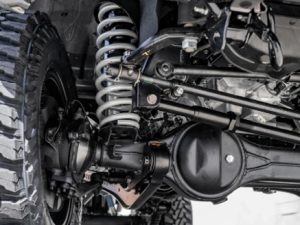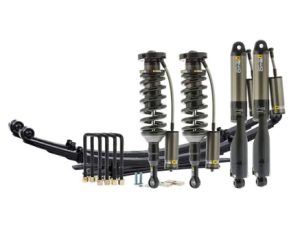Upgrading your vehicle’s suspension system is one of the most effective ways to improve handling, comfort, and overall driving performance. Whether you’re a daily driver looking for a smoother ride, a performance enthusiast aiming for better cornering and stability, or a driver needing to address wear and tear on an aging suspension system, upgrading the suspension can make a significant difference.
In this article, we’ll walk you through the different options available for upgrading your suspension system, including shocks, springs, stabilizers, and other key components. We’ll also include tables to help you compare the benefits of different suspension upgrades based on your goals.
Why Upgrade Your Suspension System?

Upgrading your suspension system can provide several benefits, depending on your needs:
- Improved Handling and Stability: Upgrading to high-performance shocks and springs can dramatically reduce body roll, improve cornering, and offer better road grip.
- Enhanced Comfort: For those who prioritize ride comfort, upgrading to softer springs or adjustable shocks can result in a smoother, more cushioned ride.
- Increased Load Handling: Heavy-duty suspension components such as load-bearing springs and reinforced shock absorbers can improve towing capacity and vehicle stability when carrying heavy loads.
- Better Durability and Performance: If you’re replacing worn-out components, high-quality aftermarket parts can increase the lifespan of your suspension and enhance its performance.
Types of Suspension Upgrades
There are several different components of the suspension system that can be upgraded. Below is a table summarizing the common upgrade options and their benefits.
| Suspension Component | Upgrade Option | Benefits | Best For |
|---|---|---|---|
| Shocks/Struts | Performance shocks or coilovers | Improved handling, reduced body roll, better damping control | Sport and performance vehicles, daily drivers |
| Springs | Lowering springs, performance springs | Reduced ride height for better handling, stiffer springs for better control | Performance, cornering enthusiasts, lowered cars |
| Sway Bars/Stabilizers | Upgraded or thicker sway bars | Improved stability, reduced body roll, better cornering response | Track cars, performance driving, stability-focused upgrades |
| Bushings | Polyurethane or solid bushings | Reduced flex, better response, enhanced control | Performance and handling enthusiasts |
| Control Arms | Adjustable control arms | Allows for more precise control of suspension geometry | Performance cars, off-road vehicles |
| Air Suspension | Air ride suspension kits | Adjustable ride height, customizable ride quality | Those needing adjustable suspension for comfort and load management |
Choosing the Right Suspension Upgrades for Your Vehicle

When upgrading your suspension, it’s important to select the right parts based on your driving style, vehicle use, and comfort preferences. Below is a comparison table to help you choose the right suspension upgrades based on your needs:
| Driving Type | Recommended Suspension Upgrades | Reason |
|---|---|---|
| Daily Driving | Performance shocks, OEM or upgraded springs, sway bars | A balance of comfort and improved handling |
| Track Driving | Coilovers, adjustable sway bars, performance bushings | Precise handling, better control, and stability |
| Off-Road Driving | Heavy-duty shocks, long-travel suspension, lift kits | Enhanced ground clearance, durability on rough terrain |
| Towing/Heavy Loads | Load-bearing springs, heavy-duty shocks, air suspension | Better load support and vehicle stability under heavy loads |
| Comfort and Ride Quality | Soft springs, adjustable coilovers, air suspension | Smoother, more comfortable ride for daily commuting |
Key Suspension Upgrades and Their Benefits
Below is a detailed breakdown of some key suspension upgrades, including their pros and cons.
| Suspension Upgrade | Benefits | Potential Drawbacks | Ideal For |
|---|---|---|---|
| Coilovers | Adjustable ride height, customizable damping rates, better handling | Can be expensive, installation can be complex | Track cars, performance enthusiasts, custom setups |
| Lowering Springs | Lowers vehicle height for improved handling and appearance | Can reduce ride comfort, may cause clearance issues | Performance drivers, car enthusiasts looking for a lower stance |
| Air Suspension | Fully adjustable ride height, customizable comfort levels | Expensive, complex installation and maintenance | Towing vehicles, luxury cars, off-road enthusiasts |
| Performance Shocks | Improved damping, reduced body roll, better road handling | May stiffen the ride, can be more expensive than OEM shocks | Drivers who want enhanced stability and performance |
| Upgraded Sway Bars | Reduced body roll, enhanced cornering stability | Can stiffen the ride, may not be ideal for comfort-focused driving | Sports cars, track cars, performance upgrades |
| Polyurethane Bushings | Increased precision and control, longer-lasting than rubber | Can transmit more road noise, may increase ride stiffness | Performance vehicles, racing cars, heavy-duty vehicles |
| Heavy-Duty Shocks | Increased durability, better load handling and off-road performance | Can be stiffer, less comfortable on smooth roads | Off-road vehicles, trucks, towing vehicles |
When to Upgrade Your Suspension System
Deciding when to upgrade your suspension system depends on your driving needs and the current condition of your suspension components. Here’s a helpful table to guide you on when to consider upgrading various parts of your suspension:
| Component | When to Upgrade | Signs to Watch For |
|---|---|---|
| Shocks and Struts | When you want better handling or if they’re worn out | Bouncing after hitting bumps, leaking fluid, poor handling |
| Springs | If you want to lower your ride or improve handling | Sagging vehicle, bottoming out, excessive body roll |
| Sway Bars | If you want better stability in corners | Excessive body roll, poor cornering, feeling of instability |
| Bushings | If they’re cracked, worn, or you want better response | Squeaky suspension, poor handling, increased road noise |
| Control Arms | If worn out or if you need better suspension geometry | Poor handling, misalignment, squeaky suspension |
| Air Suspension | If you want adjustable ride height or a smooth ride | Need for load management, desire for custom ride quality |
How to Install Suspension Upgrades
Installing suspension upgrades is a detailed process that requires the right tools and knowledge. Below is a general step-by-step guide for installing some of the common suspension upgrades:
| Upgrade | Steps for Installation | Tools Needed |
|---|---|---|
| Coilovers | 1. Lift the car and remove old shocks. 2. Install coilover kit and adjust the height. 3. Adjust damping settings as needed. |
Wrench, jack, coilover kit, spring compressors (if necessary) |
| Lowering Springs | 1. Lift the vehicle. 2. Remove the factory springs. 3. Install new lowering springs and reassemble suspension. |
Wrench, jack, spring compressors |
| Air Suspension | 1. Lift the vehicle. 2. Install air bags or air struts. 3. Set up air compressor and wiring. |
Wrench, air compressor, air strut kit, wiring tools |
| Performance Shocks | 1. Lift the vehicle and remove old shocks. 2. Install new performance shocks. |
Wrench, jack, performance shocks |
| Upgraded Sway Bars | 1. Lift the vehicle and remove the old sway bar. 2. Install new sway bars and links. |
Wrench, jack, upgraded sway bars |
| Polyurethane Bushings | 1. Lift the vehicle and remove old bushings. 2. Install new bushings using a press or hand tools. |
Wrench, press tool, new polyurethane bushings |
Conclusion
Upgrading your suspension system is an excellent way to improve your vehicle’s performance, handling, comfort, and load-bearing capacity. Whether you’re looking for better road control, enhanced comfort, or a complete overhaul for a performance vehicle, there are many options available to suit your needs. By selecting the right suspension upgrades, you can tailor your vehicle to match your driving style and preferences.
Remember, installing high-performance suspension components can be complex, so it’s important to either have the right tools or seek professional help for installation. With the right upgrades, you’ll notice a significant improvement in your driving experience.